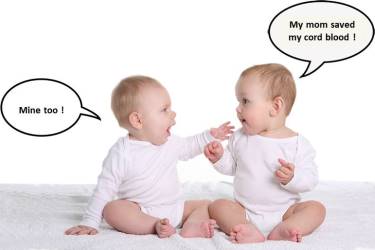Você está aqui
Twins and Cord Blood Banking

Over the past generation, the number of twin births has increased in the United States, so that compared to the historical baseline there are now over a million extra twins1. Since the 1980s, the trends towards delayed childbirth and increased utilization of fertility assistance have raised the twin birth rate from about 2% to over 3% of babies born1-3.
The majority of twins are fraternal, occurring when the mother releases two separate eggs that are both fertilized. The birth rate of identical twins, which occurs when a single fertilized egg spontaneously splits into two eggs, has not changed and is only 1 in 285 pregnancies. In other words, it used to be that half of twins were identical, but nowadays only 1 in 3 sets of twins are identical4.
Genetically, fraternal twins are the same as any other siblings, they just happen to be born at the same time. Both fraternal twins and siblings have a 25% of having matching antigen types5. That is a 1 in 4 chance of being a perfect match for a cord blood transplant or any other stem cell therapy that requires HLA matching.
The fact that twins share the same womb means that they tend to be smaller babies. Since the 1960s, it has been established that the average birth weight of full-term babies in the United States is about 8 pounds (3.6 kg) and babies smaller than 5.5 pounds (2.5 kg) are classified as low birth weight6. However, within the past decade research has changed medical ideas about what is normal for a twin. Singleton babies are expected to spend a full 39-40 weeks in gestation, but studies show that in order to avoid growth restrictions it is best for twins to be born at 37 weeks7,8. The average birth weight of twins born at 37 weeks or later is 5.5 pounds9.
Nonetheless, the fact that twins are smaller babies does mean that they have smaller placentas and less umbilical cord blood. Parents of twins are often concerned10,11 about cord blood banking: On the one hand they worry that their babies may experience the learning delays that are often associated with early birth and low birth weight12, and which can now be treated with cord blood therapy13-15. On the other hand, they worry that the collected cord blood will not be enough to be useful for therapy.
The bank Cryo-Cell has conducted the only study16 of cord blood collections from multiple births in the setting of family cord blood banking. Since 3 out of every 100 births are twins, for their study they pulled data from their last 300 multiple births and their last 10,000 singleton births. Not surprisingly, the median volume of cord blood collected was 10% smaller in multiple births. The good news was that the cord blood units from multiple births had nearly 4 times more Total Nucleated Cells (TNC) cells and nearly 8 times more CD34+ cells than the minimums required for storage.
References
- Madrigal AC. 2014 Apr 17; The Atlantic. There Really Are So Many More Twins Now
- Fell DB, Joseph KS. 2012; BMC Pregnancy Childbirth. 12:103 Temporal trends in the frequency of twins and higher-order multiple births in Canada and the United States
- CDC website. Births: Final Data for 2015
- Huggies website. Chances of having twins
- Be The Match website. HLA Matching
- Lubchenco LO, Hansman C, Dressler M, Boyd E. 1963; Pediatrics 32(5):793 Intrauterine growth as estimated from liveborn birth-weight data at 24 to 42 weeks of gestation
- ScienceDaily. 2012 June 13; Earlier birth, at 37 weeks, is best for twins, study suggests
- Dodd J, Crowther C, Haslam R, Robinson J. 2012; BJOG 119(8):964-73. Elective birth at 37 weeks of gestation versus standard care for women with an uncomplicated twin pregnancy at term: the Twins Timing of Birth Randomised Trial.
- Fit Pregnancy website. Two In The Oven
- Twiniversity blog. 2017 Nov 16; Why You Should Bank Cord Blood for Both Twins
- ViaCord blog. 2012 Sept. 19; A ViaCord Family Helps Raise Awareness about Cord Blood Banking.
- Hack M, Klein NK, Taylor HG. 1995; The Future of Children 5(1):176-196 Long-Term Developmental Outcomes of Low Birth Weight Infants.
- Sun J, Allison J, McLaughlin C, et al. 2010; Transfusion 50(9):1980-1987 Differences in quality between privately and publicly banked umbilical cord blood units: a pilot study of autologous cord blood infusion in children with acquired neurologic disorders.
- Min, K, Song, J, Kang, JY, et al. 2013; Stem Cells. 31(3):581–591 Umbilical Cord Blood Therapy Potentiated with Erythropoietin for Children with Cerebral Palsy: A Double-blind, Randomized, Placebo-Controlled Trial.
- Sun J, Song AW, Case LE, et al. 2017; Stem Cells Transl. Med. 6(12):2071-2078 Effect of Autologous Cord Blood Infusion on Motor Function and Brain Connectivity in Young Children with Cerebral Palsy: A Randomized, Placebo-Controlled Trial.
- Cryo-Cell blog. 2017 Feb. 3; Cord Blood & Tissue Banking for Twins


